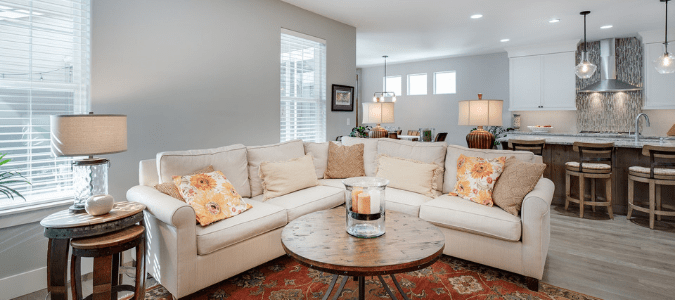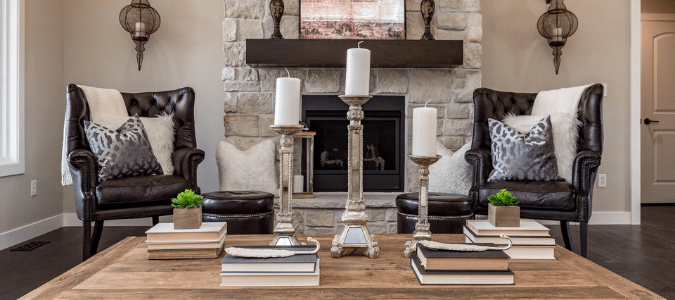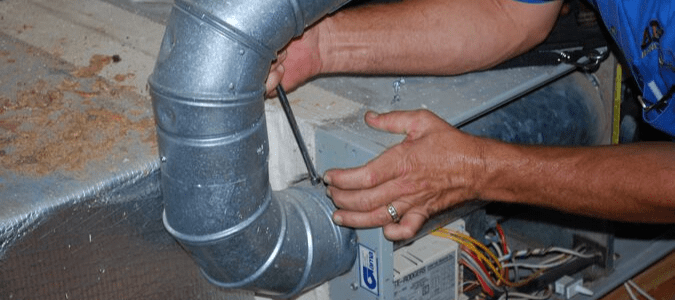
You’re freezing, so you get up to turn on the heater to warm things up. You hear your furnace click on and go sit back down, assuming you’ll feel toasty soon. A couple of minutes later, you hear the heat shut off. You repeat this process a few times when you come to terms with the fact that your furnace won’t stay on. So, what’s wrong? And, more importantly, what should you do to get your heat working again?
Your Thermocouple Is Bad
If you have a furnace with a pilot light, then you will have a thermocouple. The job of the thermocouple is to determine whether or not the pilot light is lit. This is a safety device that closes your gas valve when the pilot light goes out so gas doesn’t enter your home. You can check to see if this is your problem by seeing whether or not your pilot light is staying on. If your pilot light is continuously going out, you could have a bad thermocouple.
Your Thermostat Is Malfunctioning
If your thermostat is not working properly, it may be that this device “thinks” that your home has reached your desired temperature and prematurely shut off your furnace, when in reality it’s still chilly inside. If you want to determine if it’s your thermostat that’s causing your heat to switch off, grab a thermometer and tape it to your wall. Make sure that you place a few layers of paper towels behind the thermometer so that any heat coming through the wall doesn’t affect its reading. After fifteen minutes, check the temperature on the thermostat. It shouldn’t deviate more than a degree or two from the temperature reading on your thermostat. If it does, you probably have a malfunctioning thermostat and you will need to have it calibrated.
Your Condensate Pan Is Full
If you own a condensing furnace, it will, as the name implies, condense air into a liquid which will drain into a drip pan directed away from your home. If your drain becomes clogged, the pan will start to fill up. As the amount of liquid in your drip pan gets closer and closer to reaching capacity, it will hit a sensor that automatically turns off your furnace to prevent the condensate from spilling over. You can easily check to see if your condensate pan is full and whether you need to clear your drain to prevent this problem from happening again.
Airflow Is Restricted
When is the last time you changed your air filters? Clogged air filters can not only cause health problems, but the restricted airflow from your clogged filters limits the amount of air that your heat exchanger gets, which can cause it to overheat. When your heat exchanger starts to overheat, it flips the limit switch and closes the gas valve. Once it cools down, it will reignite and continue through this cycle. If you haven’t changed your air filters in the last thirty days, now would be the time to do so.
You Purchased A Furnace That Is Too Big
Have you recently purchased a new furnace and this is your first season using it? If so, you may have purchased an oversized unit. Furnaces need a certain amount of combustion air to allow flames to breathe properly. If your previous unit was smaller than your current unit and you had it installed in the same area, your new furnace’s flames may be struggling to breathe. If this is the case, you’ll need to bring in an experienced heating and cooling technician to advise you on your options outside of getting a correctly-sized system.
While these are all issues that you may come across, the two most common issues you’ll likely encounter with your furnace is a thermostat that doesn’t turn your furnace on and burners that aren’t igniting.

Reasons A Furnace Will Not Turn On With The Thermostat
We already mentioned that your thermostat could be the reason your central heat is not working. While there are some serious thermostat problems that could be preventing your furnace from turning on, there are also some more basic reasons that your home might be cooler than you’d like. While it may sound silly, some homeowners realize that the issue is that they don’t have their thermostat set high enough. This could happen in homes where not everyone agrees on what temperature the thermostat should be set to. If your significant other is leaving the thermostat five degrees cooler than how you would like it, and you didn’t realize the setting had been changed, there’s a chance that your home has technically heated to its specified temperature, it’s just not the temperature that you had in mind.
Another reason your thermostat may not be turning on your furnace is if someone has messed with your programmable thermostat. Although you have the heat setting on, your thermostat could just be following its directions to not turn on for another hour or two. Try checking to see if your thermostat has been reprogrammed, then go from there. Sometimes during cleaning a setting can be changed without your noticing, which is another thing to doublecheck.
Your furnace could not be turning on because of an issue that is unrelated to the thermostat but may seem related at first. For example, you could’ve blown a fuse that is connected to your heating unit rather than the problem being with your thermostat. Go check your circuit breaker and flip any breaker that is in the OFF position to the ON position. Doing so should resolve the issue in these situations.
The last thing you can try before calling in a heating and cooling specialist is to make sure that your thermostat’s sensors aren’t dirty. Over time, dust can build up in your thermostat, which affects how well its sensors can register the temperature of the room. To check this on your own, simply unscrew the thermostat’s cover and use a soft brush to remove any dust that you might find.

What If My Furnace Is Not Igniting The Burners?
If you suspect that your furnace is not working because the burners aren’t igniting and want to try to troubleshoot the issue, check to make sure your gas line is turned on. You can usually see if things are working by turning on another gas appliance, such as your gas stove. If it appears that your gas is turned on, there could be a gas leak that is preventing your furnace from igniting your burners. If you smell gas near your unit, leave your home immediately and call your local utility provider.
If your problem is not with your gas line, see if your pilot light is lit, since your pilot light or ignition sensor is the most common culprit behind a furnace that won’t ignite. If this is your first time turning on your furnace this season, keep in mind that it may take a little extra time for the pilot light to turn on. One giveaway that your problem is with your pilot light is if you hear the furnace click on, but it doesn’t fire up. If your pilot light is the problem, take a look at your heater for directions on how to relight your pilot light, as this information is usually on the label.
Lastly, as with many other issues with your heating and cooling system, your air filters may be to blame. If these important parts haven’t been changed in a while, they can become clogged and block airflow to your heat exchangers. To prevent itself from overheating, the burners will shut off. If a dirty air filter is the root cause of your problem, you may also need to clear dust out of vent registers at the same time as you are either replacing or cleaning your filter.
If you find yourself in the unfortunate situation of having a heating problem, you may also wonder how long a furnace cycle should last. Are you just cold and anxiously waiting for the furnace to turn back on again, or is the furnace actually not circulating enough hot air to heat your house to your desired temperature?

How Often Should My Furnace Cycle?
Furnaces should cycle about two to three times every hour, with each cycle lasting about ten to twenty minutes. The technical term for your furnace not staying on or cycling how it should is short cycling. Other than discomfort, there are a couple of other reasons why short cycling is bad for you and your furnace.
First, a short cycling furnace can cause damage over time, resulting in premature costly repairs. Turning on and off constantly puts excess stress on the different parts of your unit, causing them to wear out much faster than they should. In addition, your energy bills can skyrocket. Similar to a car, it takes a significant amount of energy to turn a furnace on and turn off. When your furnace is constantly turning on and off, it has to work much harder to heat your home, resulting in higher energy bills. Finally, homeowners that have a furnace that’s short cycling typically report that some areas of the home may be much warmer than others because your furnace never makes it all the way through a cycle.
Fortunately, with proper furnace maintenance, you can keep your furnace’s cycle normal and prevent costly repairs.

Furnace Maintenance Tips
Many problems that arise with furnaces can be easily prevented with proper furnace maintenance. Most heating and cooling repair companies offer furnace maintenance services, and homeowners can benefit from having a professional who knows their way around these systems to perform routine diagnostic tests and make adjustments when needed. Experts recommend having a licensed technician go through an air conditioner maintenance checklist in the spring to get your system ready for peak AC season and to have another service call in the fall to gt your furnace ready for the cooler months.
Some of the common tasks that a heating and cooling technician will carry out to maintain your furnace include:
- Cleaning your combustion chamber. In your combustion chamber, fuel mixes with air when it is ignited, which generates heat, as well as carbon soot, water vapor and carbon dioxide. This build-up of soot can cause your chamber walls to become corroded over time, so it’s important that this debris is routinely removed.
- Checking the flames to ensure they are burning evenly and blue. Yellow flames indicate that your burners are still dirty.
- Clean around your pilot and flame sensor.
- Inspect your drive belt for any signs that it may be damaged or fraying.
- Inspect your flue pipe to make sure there are no holes in your pipe that could leak carbon monoxide and no signs of corrosion. While small holes can be patched, corroded pipes must be replaced.
- Change your air filter. Your annual furnace check-up is a great time to check this off your to-do list. You’ll want to make sure you use the correct type of air filter for your unit.
ABC Can Repair And Maintain Your Furnace
Furnace problems can make your home uncomfortable, and most homeowners have neither the knowledge nor the time to effectively troubleshoot most of these problems. The licensed professionals at ABC Home & Commercial Services can quickly handle any type of furnace problem you may run across. We even offer 24/7 emergency services for those middle of the night repairs that can’t wait until the morning. With ABC’s help, you’ll be able to stay warm and cozy inside even when temperatures drop.
